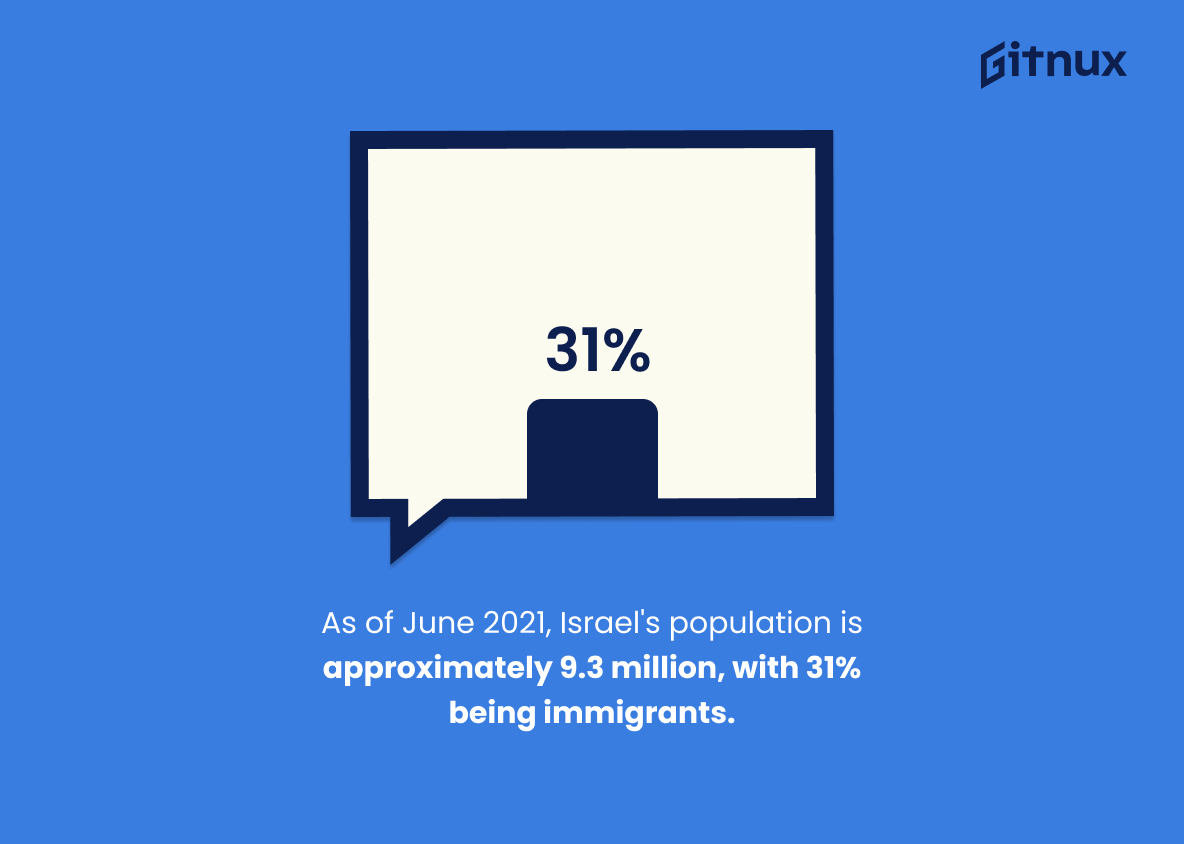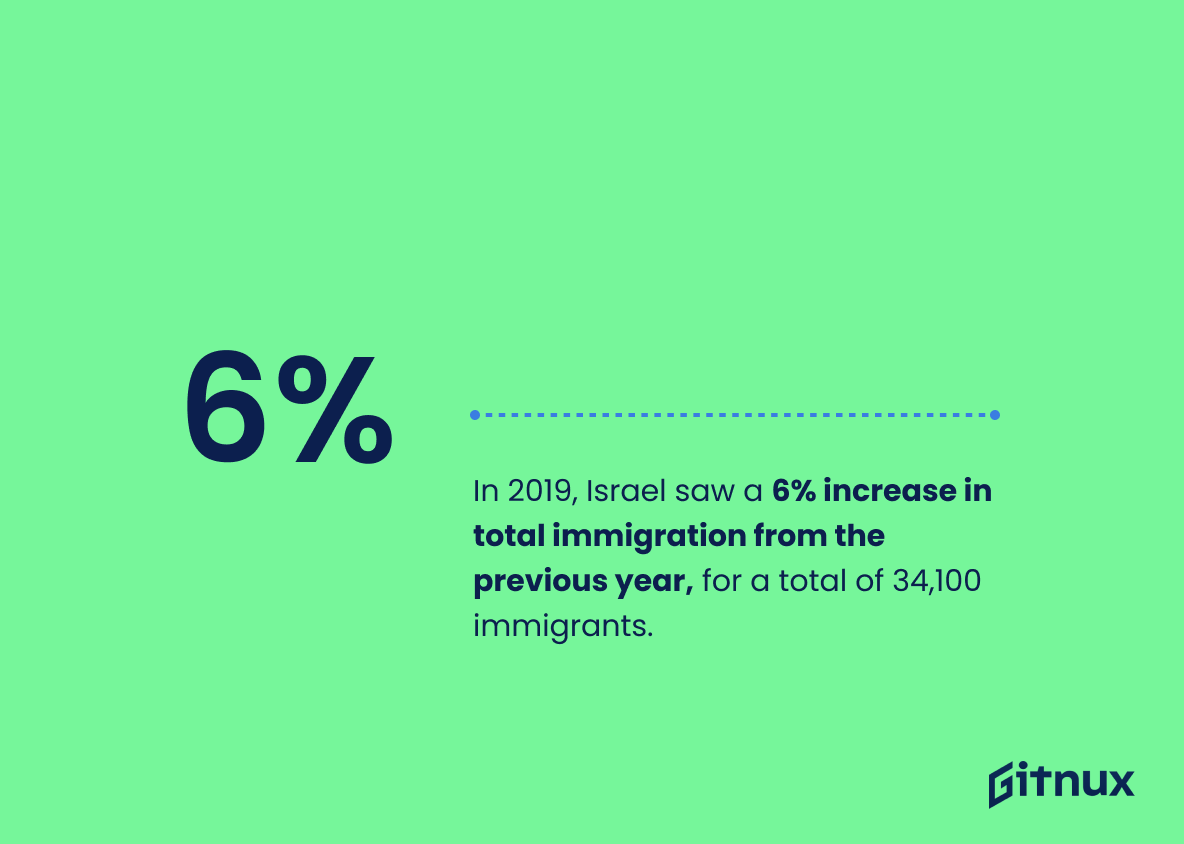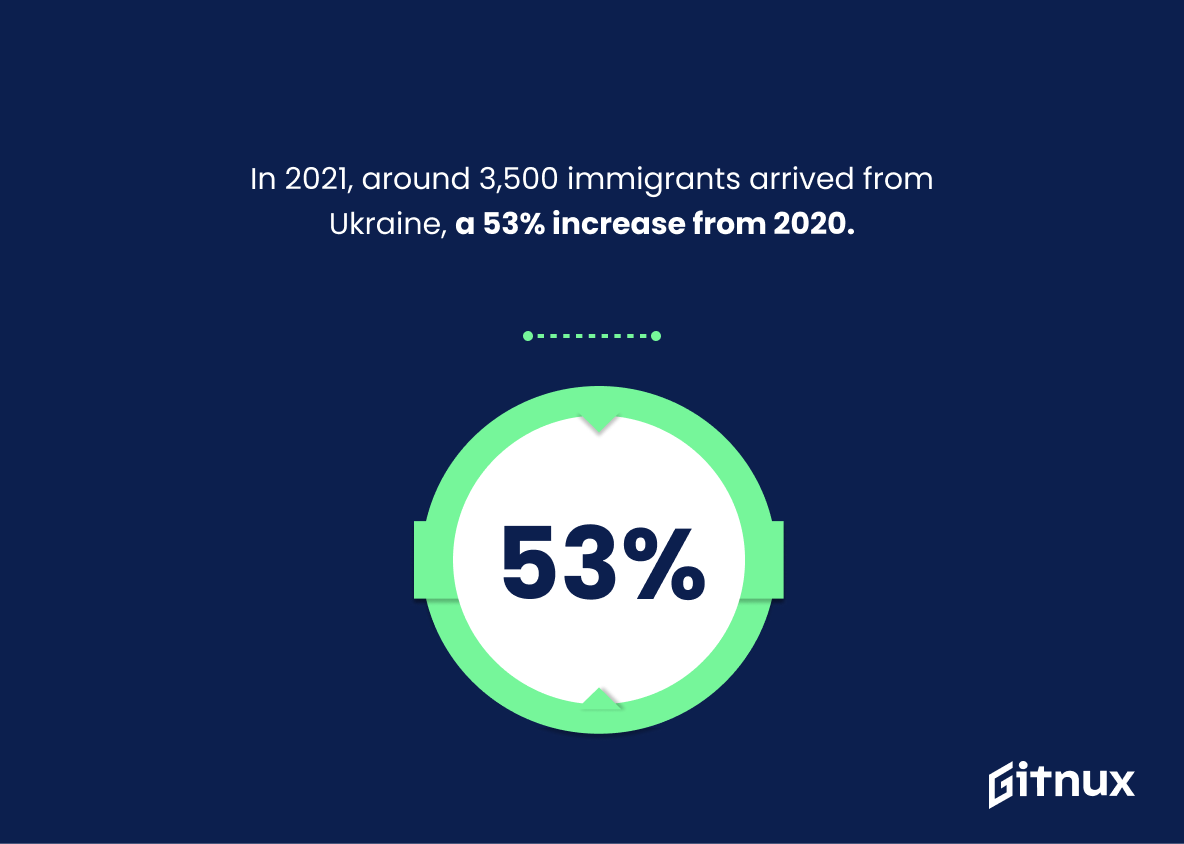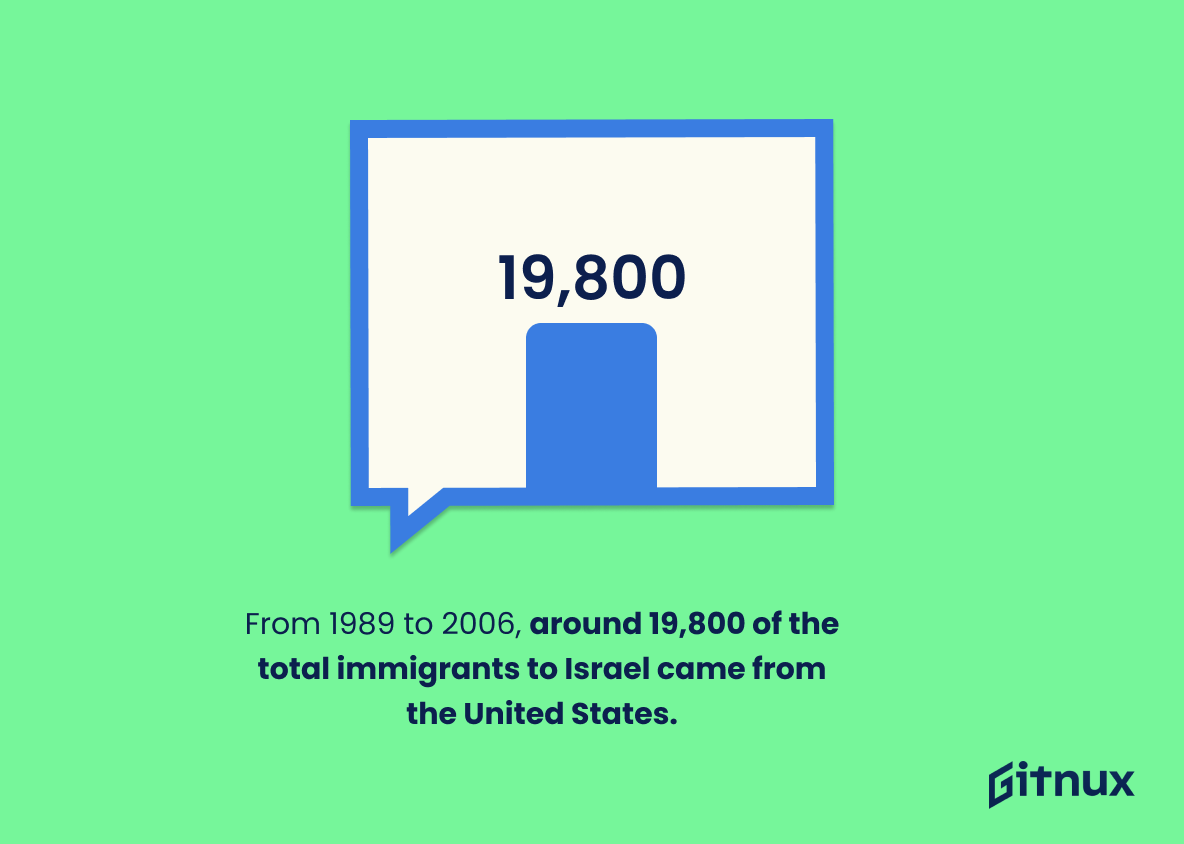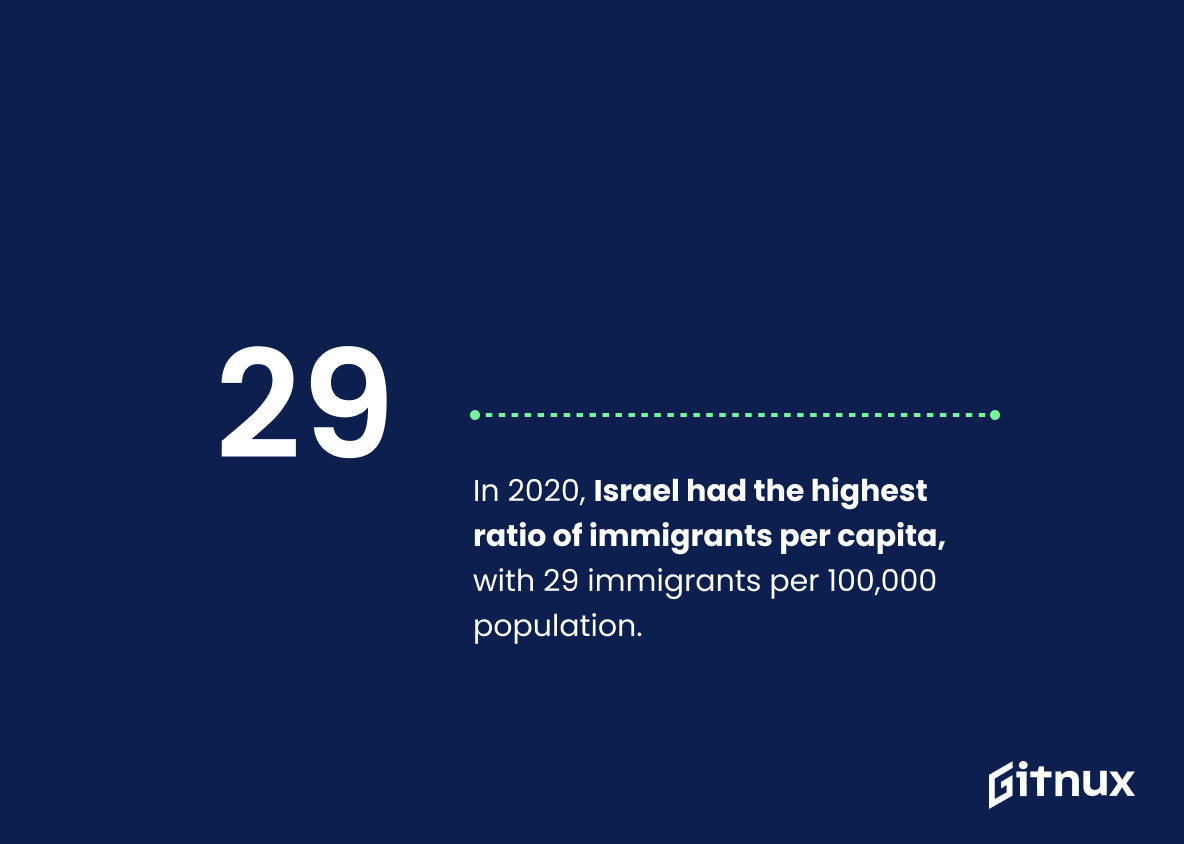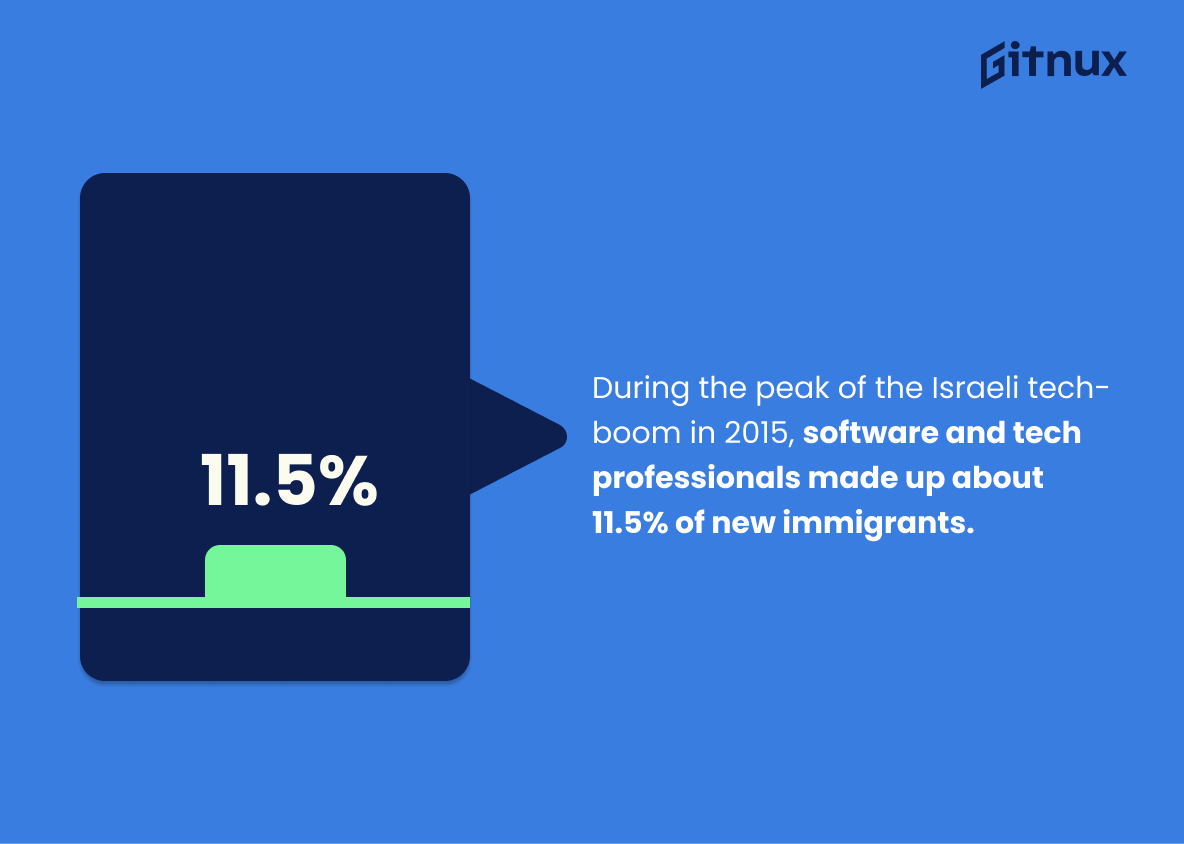Immigration to Israel has been a major part of the country’s history since its founding in 1948. Over 3.3 million people have immigrated to Israel over the past 73 years, and this number continues to grow each year as more individuals seek out new opportunities in the Jewish state. In 2019, there was a record-breaking 34,100 immigrants who moved to Israel from all around the world – including 551,000 from Former Soviet Union countries during 1990s; 4500 Ethiopians in 2021; 25% increase of Jews coming from Russia compared with 2018; 31% (2.9 million) total population being immigrants as of June 2021; 6% overall immigration growth rate for 2019 compared with previous year; 12% French Jews making Aliyah that same year (3194); 41 % rise on North American immigration numbers for 2020 versus 2019 ; 53 % Ukrainian immigrant influx into Israeli territory by end of 2021 ; 5 .5 % Brazilian newcomers registered at highest level within last 50 years ; 178 , 000 asylum seekers & refugees living inside borders by end 2018 mainly Eritreans & Sudanese nationals plus 19 , 800 US citizens between 1989 – 2006 period + British aliyah up 34 % first half ‘19 vs similar time frame one yr before + 91 percent South African migration surge reported throughout ’19 alongside 44K Filipino workers present until 2016 along w/ 29 per 100k ratio regarding global migrants towards nation’s shores during 2020 while 11 .5 software / tech professionals made up portion amongst 2015 peak Israeli tech boom era finally culminating w/ ten yrs high figure re:34 K arrivals recorded back 2018 .
This statistic is a powerful reminder of the immense impact that immigration from the Former Soviet Union had on Israel during the 1990s. It speaks to the sheer number of people who made the journey to Israel in search of a better life, and the lasting impact that their presence has had on the country. It is a testament to the strength and resilience of the Israeli people, and a reminder of the importance of immigration in the country’s history.
A record-breaking number of Ethiopian immigrants, over 4,500, arrived in Israel in 2021.
This record-breaking statistic of Ethiopian immigrants arriving in Israel in 2021 is a testament to the country’s commitment to welcoming immigrants from all backgrounds. It is a sign of progress in the country’s immigration policies and a reminder of the importance of providing a safe and secure home for those seeking a better life. This statistic is a powerful reminder of the potential of immigration to create a more diverse and vibrant society.
Israel Immigration Statistics Overview
There was a 25% increase in Jews immigrating to Israel from Russia in 2019, as compared to the previous year.
This statistic is significant in the context of Israel Immigration Statistics because it demonstrates a notable surge in the number of Jews from Russia who chose to make Israel their home in 2019. This influx of immigrants is indicative of a larger trend of Jews from around the world seeking to immigrate to Israel, and it is an important statistic to consider when discussing the overall immigration patterns to the country.
As of June 2021, Israel’s population stands at approximately 9.3 million people, 2.9 million (31%) of whom are immigrants.
This statistic is a powerful reminder of the immense impact immigration has had on Israel’s population. It demonstrates that nearly one-third of the country’s population is comprised of immigrants, highlighting the importance of immigration to the nation’s growth and development. Furthermore, it serves as a testament to the country’s commitment to welcoming and integrating immigrants into its society.
In 2019, Israel saw a 6% increase in total immigration from the previous year, for a total of 34,100 immigrants.
This statistic is a testament to the fact that Israel is a desirable destination for immigrants. The 6% increase in total immigration from the previous year indicates that more and more people are choosing to make Israel their home. This is an important indicator of the country’s success in providing a safe and welcoming environment for those seeking a new home.
In 2020, there was a 41% increase in immigrants from North America compared to the previous year.
This statistic is significant in the context of Israel Immigration Statistics because it indicates a notable shift in the number of immigrants from North America to Israel in 2020. This could be indicative of a larger trend in immigration to Israel from North America, and could be used to inform future policy decisions and research.
In 2021, around 3,500 immigrants arrived from Ukraine, a 53% increase from 2020.
This statistic is indicative of a significant shift in the immigration landscape of Israel. It shows that the number of immigrants from Ukraine has increased dramatically in the past year, suggesting that more people are choosing to make Israel their home. This could be due to a variety of factors, such as economic opportunities, political stability, or a desire to be closer to family and friends. Whatever the reason, this statistic is an important indicator of the changing dynamics of immigration in Israel.
In 2018, about 5.5% of immigrants came from Brazil, which was the highest number of Brazilian immigrants to Israel in the past 50 years.
This statistic is a testament to the increasing number of Brazilian immigrants to Israel in the past 50 years, indicating a significant shift in the country’s immigration patterns. It is a noteworthy milestone that speaks to the growing diversity of the Israeli population and the country’s welcoming attitude towards immigrants. This statistic is an important part of the larger story of Israel’s immigration history and provides valuable insight into the changing dynamics of the country’s immigration landscape.
From 1989 to 2006, around 19,800 of the total immigrants to Israel came from the United States.
This statistic is significant in the context of Israel Immigration Statistics because it demonstrates the impact that the United States has had on the country’s immigration patterns. It shows that the US has been a major source of immigrants to Israel over the past two decades, and that the US has had a significant influence on the country’s population growth.
British immigration to Israel increased over 34% in the first half of 2019 compared to the same period in 2018.
This statistic is a telling indication of the growing trend of British citizens immigrating to Israel. It highlights the increasing popularity of Israel as a destination for British immigrants, and provides insight into the motivations of those who are choosing to make the move. This statistic is an important piece of the puzzle when it comes to understanding the current state of Israel’s immigration landscape.
Since the founding of Israel in 1948, more than 3.3 million people have immigrated to the country.
This statistic is a powerful testament to the success of Israel’s immigration policies since its founding. It speaks to the country’s ability to attract and welcome people from all over the world, and to provide them with a safe and prosperous home. It is a testament to the strength of the Israeli people and their commitment to creating a vibrant and diverse society. This statistic is a reminder of the importance of immigration in the development of Israel and its culture.
In 2019, the Jewish Agency reported a significant increase of 91% in immigration from South Africa to Israel.
This statistic is a powerful indicator of the growing trend of immigration from South Africa to Israel. It speaks to the increasing desire of South Africans to make the move to Israel, and the potential impact this could have on the country’s population and economy. It also highlights the success of the Jewish Agency’s efforts to encourage and facilitate immigration from South Africa to Israel.
Prior to 2021, the largest number of Ethiopians to immigrate to Israel in a single year was 6,364 in 1991.
This statistic is a powerful reminder of the immense impact that immigration has had on Israel’s population. It highlights the fact that, even before 2021, a significant number of Ethiopians had already made the journey to Israel, demonstrating the country’s long-standing commitment to welcoming immigrants. This statistic is a testament to the strength of Israel’s immigration system and its ability to accommodate large numbers of people.
By the end of 2016, there were around 44,000 Filipino workers in Israel.
This statistic is a telling indication of the impact of immigration on Israel’s workforce. It shows that Filipino workers have become an integral part of the Israeli economy, with their presence increasing significantly over the past few years. This statistic is a testament to the fact that immigration has been a major factor in the growth of Israel’s economy.
In 2020, Israel had the highest ratio of immigrants per capita, with 29 immigrants per 100,000 population.
This statistic is a powerful indicator of the importance of immigration to Israel. It shows that the country is highly welcoming to immigrants, with a large proportion of its population being made up of those who have chosen to make it their home. This statistic is a testament to the country’s commitment to providing a safe and welcoming environment for those who wish to settle there.
During the peak of the Israeli tech-boom in 2015, software and tech professionals made up about 11.5% of new immigrants.
This statistic is a telling indication of the draw of Israel’s tech industry. In 2015, the Israeli tech-boom was at its peak, and the fact that software and tech professionals made up 11.5% of new immigrants speaks to the appeal of the country’s tech sector. This statistic is a testament to the success of Israel’s tech industry and the potential it holds for those looking to make a new start in the country.
In 2018, 34,000 immigrants moved to Israel, which was the highest number in a decade.
This statistic is a testament to the fact that Israel is becoming an increasingly attractive destination for immigrants. It shows that the country is welcoming more and more people from around the world, and that it is becoming a hub for international migration. This is an important development for the country, as it can help to diversify its population and bring in new ideas and perspectives. Additionally, it can help to boost the economy, as immigrants often bring with them skills and resources that can help to create jobs and stimulate growth.
Conclusion
In conclusion, Israel has seen a steady increase in immigration over the past decade. From 1989 to 2006, around 19,800 of the total immigrants to Israel came from the United States and by 2018 that number had increased significantly with 34,000 people making Aliyah. In 2019 there was a 6% increase in total immigration compared to the previous year and 2020 saw an even higher rate of 41% growth for North American immigrants alone. 2021 is already proving itself as another record-breaking year for Israeli immigration with 4500 Ethiopians arriving this year – more than any other since 2013 – and 53% increases from Ukraine compared to last year. With such high numbers coming from all corners of the world it’s clear that Israel remains an attractive destination for those looking for new opportunities or seeking refuge elsewhere.
References
0. – https://www.www.timesofisrael.com
1. – https://www.www.nif.org
2. – https://www.jewishnews.timesofisrael.com
3. – https://www.population.un.org
4. – https://www.www.jpost.com
5. – https://www.www.cbs.gov.il
6. – https://www.www.ilo.org
7. – https://www.www.jewishpress.com
8. – https://www.en.globes.co.il
9. – https://www.www.jta.org
10. – https://www.www.al-monitor.com
11. – https://www.www.jewishvirtuallibrary.org

